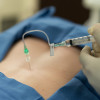
 IJCP Editorial Team
IJCP Editorial Team
Pregnancy Outcomes of Previable and PROM following Laser Photocoagulation for Twin-Twin Transfusion Syndrome
The present study describes the pregnancy outcomes of patients who experienced pre-viable and peri-viable pre-labor rupture of membranes (PROM) after treating twin–twin transfusion syndrome.
It conducted a retrospective cohort study of patients with pregnancies complicated by twin–twin transfusion syndrome and treated with fetoscopic laser photocoagulation at a single fetal center and subsequently experienced PROM from April 2010 to June 2019. It looked for infant survival and latency from PROM to delivery. The study grouped the patients with gestational age at PROM (before 26 weeks of gestation and 26 weeks or later) and; stratified the group with PROM before 26 weeks of gestation by gestational age at PROM for further description of outcomes.
The study observed-
- Development of PROM in two-hundred fifty of 653 patients (38%), 81 before 26 weeks of gestation and 169 after 26 weeks of gestation.
- In the setting of PROM before 26 weeks of gestation, the rate of survival of both twins to neonatal intensive care unit (NICU) discharge was 46.3%, contrasting 76.9% in the setting of PROM at 26 weeks of gestation or later; the survival rate of at least one twin was 61.2% and 98.5%, respectively.
- PROM was experienced by fourteen, 22, and 45 patients at 16–19 6/7, 20–22 6/7, and 23–25 6/7 weeks of gestation, respectively.
- Survival of both twins and at least one twin to NICU discharge was 25.0%, 47.4%, 52.8% (for two), and 33.3%, 47.4%, and 77.8% (for at least one), respectively, among the described groups.
- Latency longer than 48 hours in fifty-seven of the 81 patients with PROM before 26 weeks of gestation.
- Improvement in overall survival (69.6% vs. 53.7%, respectively) when latency lasted longer than 48 hours in the setting of PROM before 26 weeks of gestation.
- With latency >48 hours and PROM at 16–19 6/7, 20–22 6/7, and 23–25 6/7 weeks of gestation, survival of both twins to NICU discharge was 60.0%, 61.5%, and 60.7%, respectively, and survival of at least one twin was 80.0%, 61.5%, and 85.7%, respectively.
This study shows that earlier gestational age at PROM after laser photocoagulation links with longer latency but lower survival rates. When PROM occurs before 26 weeks of gestation and latency exceeds 48 hours, neonatal survival rates are improved markedly.
Forde B, Fresch R, Masters H, et al. Comparison of Pregnancy Outcomes of Previable and Periviable Rupture of Membranes After Laser Photocoagulation for Twin–Twin Transfusion Syndrome. Obstetrics & Gynecology. 2022;140(6):p 965-973. DOI: 10.1097/AOG.0000000000004970

IJCP Editorial Team
Comprising seasoned professionals and experts from the medical field, the IJCP editorial team is dedicated to delivering timely and accurate content and thriving to provide attention-grabbing information for the readers. What sets them apart are their diverse expertise, spanning academia, research, and clinical practice, and their dedication to upholding the highest standards of quality and integrity. With a wealth of experience and a commitment to excellence, the IJCP editorial team strives to provide valuable perspectives, the latest trends, and in-depth analyses across various medical domains, all in a way that keeps you interested and engaged.













Please login to comment on this article